‘Why do we celebrate handloom?’, is a question we often ask. In times of mechanisation and powerlooms, isn’t it progress that we must applaud? Truly, technology has made work faster, and the end product cheaper. However, in the bargain, the thousands of families that were once supported by patrons, are fading out. The mechanics of the complex loom, and working it without electricity, is becoming a thing of the past. And one of the 64 arts and crafts of India, is fading to oblivion. The reason we celebrate handloom, is because this craft has the human element in it. When you buy handloom, you support the farmer, the weaver and the society around them. When you celebrate handloom, you celebrate the nation’s unique identity as well as the unique story of each handloom, built by its people. With Andhra Pradesh being home to one of the richest and most vibrant clusters of handloom societies, we take you on a trip through these villages in Andhra Pradesh, to meet these weavers and salute their work.
1. Pristine at Ponduru Distance: 30 km from Srikakulam
Distance: 30 km from Srikakulam
Fact file: The only Andhra village for Khadi, it has also received the Geographical Indications tag for its unique identity.
Home to the finest and softest Khadi available, the legend goes that Mahatma Gandhi himself visited the village, and showed a liking towards wearing Ponduru Khadi. The feel of this cotton fabric is soft, and it is both handspun and handwoven. In fact, it is so appreciated, that it is exported to other countries and also has many designers in India use it as their base material. Available in a range of pastel and bright colours, many handloom lovers make the trip, specifically to this village in Andhra Pradesh, to procure its saris and material. Along with Khadi sarees in cotton and silk, the dhotis in Khadi are much preferred for the classy look and comfortable feel of the garment. With almost every house having a pit loom, the entire family works together in order to create this beautiful fabric. The weaving of Ponduru handloom and Khadi materials is also done in other villages up to Vizianagaram. Most weavers prepare the cloth to order, and will not sell directly. However, the society and a few weavers do sell running material and a few sarees.
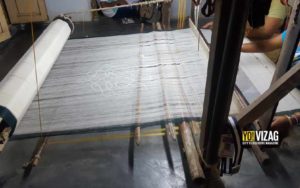 While it’s difficult to pinpoint exactly when my love for handloom started, I’ve been wearing and seeing a myriad of textiles all my life. However, after visiting several weaving clusters my love and reverence for handloom have increased. Their dexterity and skill and lack of support affected me deeply, and I wanted to do something about it. That’s when I started wearing handloom as often as I could. I also started #handloommonday on my social media, where I only wear handloom and handmade garments every Monday without fail. I was extremely happy when a few relatives started doing the same. I love everything about handloom! Every piece is perfectly imperfect which makes it unique. I can’t pick one favourite sari, as I have many. I try collecting sarees across India, and after seeing my love for saris, both my grandmothers have started giving me their saris. I love them all because they are no longer made. Those are very special to me.
While it’s difficult to pinpoint exactly when my love for handloom started, I’ve been wearing and seeing a myriad of textiles all my life. However, after visiting several weaving clusters my love and reverence for handloom have increased. Their dexterity and skill and lack of support affected me deeply, and I wanted to do something about it. That’s when I started wearing handloom as often as I could. I also started #handloommonday on my social media, where I only wear handloom and handmade garments every Monday without fail. I was extremely happy when a few relatives started doing the same. I love everything about handloom! Every piece is perfectly imperfect which makes it unique. I can’t pick one favourite sari, as I have many. I try collecting sarees across India, and after seeing my love for saris, both my grandmothers have started giving me their saris. I love them all because they are no longer made. Those are very special to me.
Raji Mavuri, Kanchi Kamakshi Silks
2. Unveiling the Uppada
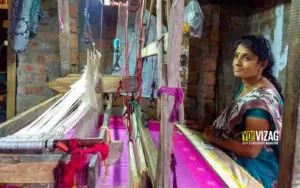 Distance: 135 km from Vizag
Distance: 135 km from Vizag
Fact file: Awarded the Geographical Indication tag, Uppada is one of the few villages in Andhra Pradesh that prospers in handloom, thanks to the unique fabrics it creates.
Shopping for buttery silks in pretty pastels is the reason that takes many buyers to the village of Uppada every day. With many stores along the entire street selling this beautiful fabric, prepare to be amazed at the riot of colours, designs and styles available. With a large percentage of the weavers here being women, each sari takes approximately ten days to two months for weaving, depending on the complexity of the design. Those heading here for their wedding sarees, must check out the exquisite designer pieces available. The Jamdani style of weave, which was learned from Bangladesh approximately 300 years ago, is a must buy. With weavers hailing from neighbouring villages as well, a drive to this destination will showcase many homes and looms busy at work.
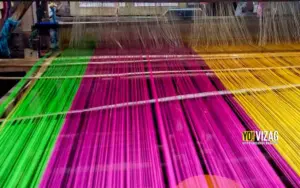 I wear only handloom or Khadi cotton and only wear kora. I don’t even wear silks. My message to the youngsters that I meet is to wear cottons as much as possible and prefer only natural dyes over chemical colours. At Sankalpa, we give livelihood to weavers. In the future, I hope to see a University course on weaving and dyeing with natural dyes. Till then, we would continue to build awareness and conduct free internships for anyone to come, learn and work on this.
I wear only handloom or Khadi cotton and only wear kora. I don’t even wear silks. My message to the youngsters that I meet is to wear cottons as much as possible and prefer only natural dyes over chemical colours. At Sankalpa, we give livelihood to weavers. In the future, I hope to see a University course on weaving and dyeing with natural dyes. Till then, we would continue to build awareness and conduct free internships for anyone to come, learn and work on this.
Parvathi, Sankalpa Art Village
3. Mesmerised at Mangalagiri
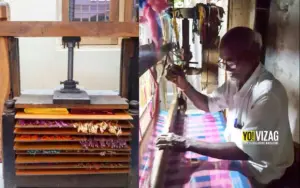
Distance: 10 km from Vijayawada
Fact file: This village is also famous for its temples. The Panakala Narasimhaswami Temple is much visited, and legend says that the Lord accepts only half of the offering of panakam (jaggery water) made here.
From colourful and soft cottons to options in silks, for saris, kurtas, and dress materials, Mangalgiri is a destination that attracts visitors to Vijayawada. The short 10 km detour, is well worth the ride, as the narrow lane of Mangalagiri, in Andhra Pradesh, beckons with many small shops that sell the bright and pastel coloured handloom. While traditional Mangalagiri material sported the unmistakable gold borders, today there are many other options available too. The yarn undergoes a month-long process of being dyed, dried, and prepared for the loom. Once on the loom, it takes a day to be created. With a wide variety of colours and combinations to choose from, the high quality, exquisite feel, and easy maintenance make these irresistible for the buyer.
4. Vivacious Venkatagiri
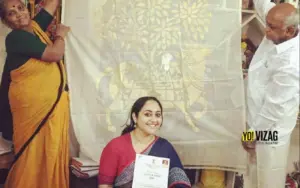 Distance: 80 km from Nellore
Distance: 80 km from Nellore
Fact file: Once an independent princely state, Venkatagiri is famous for its historical monuments, well-maintained royal palace, temples, and fort. This is also home to the Indian Institute of Handloom Technology.
Once famed for their real-silver with real-gold borders, these saris are often treasured possessions passed down from grandmothers to granddaughters.
Those seeking classy, airy, and light handwoven saris with elaborate zari borders, often find their answer in Venkatagiri. Soft and durable, this village is famed for Jamdani style saris, the technique of which was imported from Bangladesh. Pure cotton saris, cotton and silk mix, and pure silk saris are the range of options available here. The 18th Indian sari to be awarded Geographical Indication (GI), Venkatagiri saris were once woven for royalties who patronised a small cluster of weavers. Traditional motifs of swans, peacocks, parrots, and geometrical designs can be seen here.
 Most of what I wear is handloom, and I prefer cottons, because it suits the hot climate of our region. I prefer lightweight handloom saris for the same reason and my collection includes Venkatagiri, Chanderi and Kota among others. I have a few treasured saris in my collection, and these include a Kanjivaram and a Venkatagiri which are over 40 years old. I also make it a point to wear blacks on Saturday, whites on Monday and yellows on Thursday. We aim to give new life to weaves and weavers through Crafts Council of Andhra Pradesh (CCAP). And I feel that the new generation can keep the handloom heritage alive, by giving a designer touch to these or even by sporting the ethnic look once in a while.
Most of what I wear is handloom, and I prefer cottons, because it suits the hot climate of our region. I prefer lightweight handloom saris for the same reason and my collection includes Venkatagiri, Chanderi and Kota among others. I have a few treasured saris in my collection, and these include a Kanjivaram and a Venkatagiri which are over 40 years old. I also make it a point to wear blacks on Saturday, whites on Monday and yellows on Thursday. We aim to give new life to weaves and weavers through Crafts Council of Andhra Pradesh (CCAP). And I feel that the new generation can keep the handloom heritage alive, by giving a designer touch to these or even by sporting the ethnic look once in a while.
Ammaji Rayudu, CCAP, Jt. Secretary
5. No place like Narayanapuram
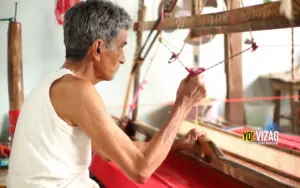 Distance: 106 km from Vizag
Distance: 106 km from Vizag
Fact file: People from the older generations recollect how saris here would cost as less as Rs. 10 in the ‘60s but aren’t inexpensive anymore
The softest of cotton saris, in a range of colours, come from this village. With many homes seen with bright colored threads strung on traditional handlooms, Narayanapuram has approximately 50 maggams (looms), which are used in rotation. Their handloom is dedicated to preparing Bobbili saris, their customers comprise of the sahukars of Bobbili in Andhra Pradesh. With no functional society, produce directly goes to the businessmen in Bobbili. On average, eight saris are prepared per week, with the money and threads provided by Bobbili saahukars. The Bobbili saris they make are however famed for their softness and low cost. The pure cotton saris though not as inexpensive anymore, are still economically priced.
6. Awed at Angara
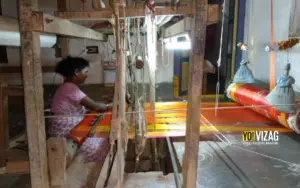
Distance: 200 km from Vizag
Fact file: 800 weavers and 400 looms approximately constitute the Angara society. These materials can be purchased either from the village or from Dwarapudi, where the retail center is located.
Winding lanes through the scenic district of East Godavari, can take you to the quiet village of Angara. This is where most of the so-called Uppada cotton saris are woven. From colourful jacquards to buta saris, dress materials, cottons, kuppadam silks and much more are available here. This community presents its work with immense pride and has also received many awards. Constantly looking to innovate, they are creating slab yarn, gine cottons, and other saris. With many neighbouring villages also supplying to Angara, this place is ideal for purchasing kurta material and soft cotton handloom towels too.
Do your bit:
1. Buy handloom only at the societies, or directly from weavers. This ensures that the benefit goes directly to the makers. This also ensures that you get handloom material only.
2. When shopping for a special occasion like a wedding, pick up a handloom trail and shop at the clusters along the way.
3. Most of the societies are savvy too, and once you meet them personally, you can next shop with them via Whatsapp pictures and online money transfers.
4. Support the lesser-known crafts, as it is here that the weavers struggle the most.
5. Encourage your children to visit such clusters. The shift in mindset for the next generation begins with you.


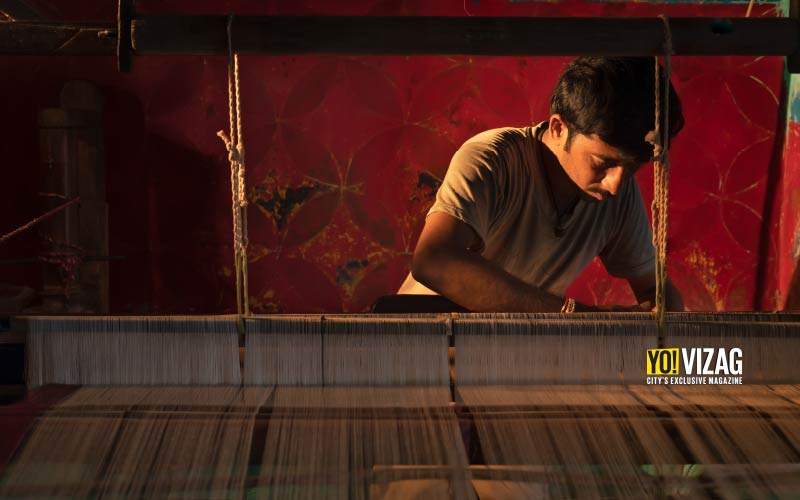







Discussion about this post